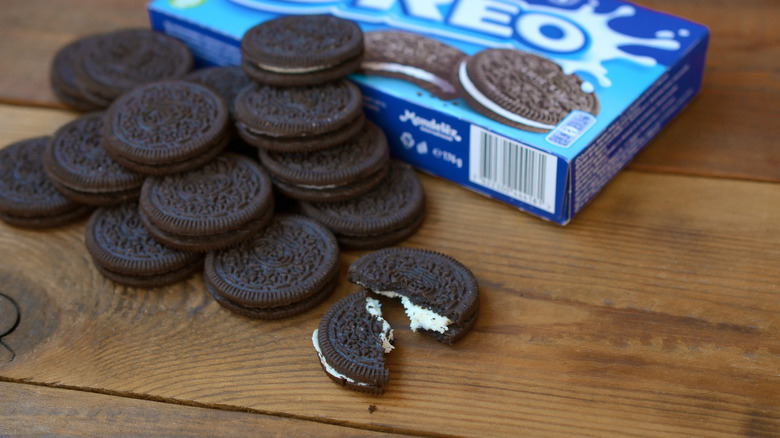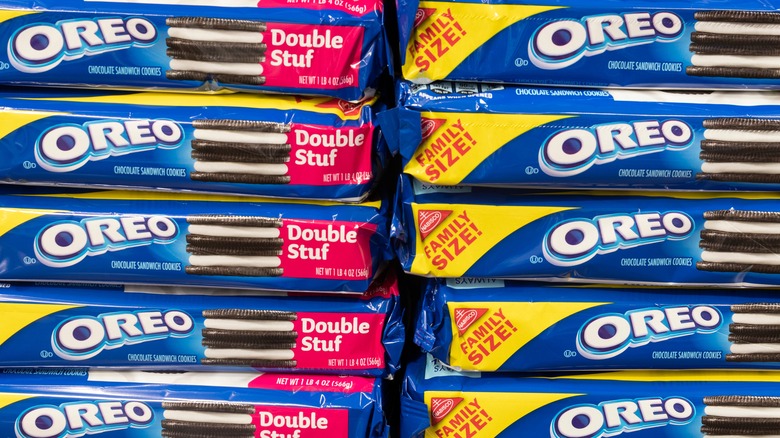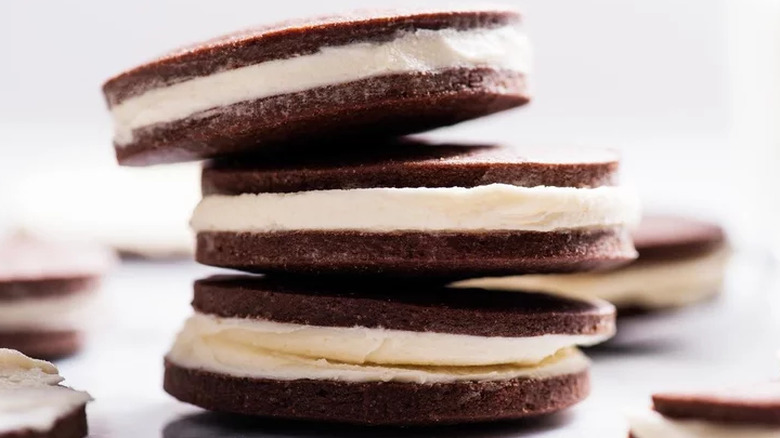Here's What's Actually In Oreo Filling
A simple blob of frosting between two chocolate wafers makes an American icon. Even after a century in business, Oreo sales and popularity continue an upward trend according to Market Watch. They remain relevant by answering to massive changes in America's eating habits. In 1991, Nabisco switched from lard to partially hydrogenated vegetable oil, per The New York Times; today, they are savvy marketers who lean on social media to get an ever-growing menu of iterations to trend.
Oreos are ubiquitous, but they remain shrouded in some mystery. For one thing, the name's origin has never been settled. According to Time, it's most likely a nod to the original golden packaging (in French, the word or means "gold"). Even the cookie's embossed design is clouded with some medieval-era enigma. The Atlantic digs beyond the obvious — Oreo's name and a variant of Nabisco's logo — to reveal that logo and the dot with radiating triangles each have roots in the Freemasons and Knights Templar. But, we're more concerned with what's between those chocolate wafers.
It's called creme for a reason
"Cream" isn't on the ingredient list for Oreos. There's no dairy at all. However, they are likely to not quite pass muster as vegan. Oreos are produced alongside products that contain milk — it's up to you to decide if that's a line you're willing to cross.
In short, Oreo's "creme" is hydrogenated vegetable oil, high fructose corn syrup, soy lecithin, and vanillin. Each of those come with some concerns. Hydrogenated vegetable oil has been associated with several adverse side effects according to Healthline. High fructose corn syrup's bad reputation is well documented (via the Cleveland Clinic). Soy lecithin is an emulsifier that's in many foods. According to Harvard Medical School, soy products should be eaten in moderation. Especially, the more processed forms that can produce more adverse effects. Vanillin is an artificial flavor derived from wood and petrochemicals (via Scientific American). While that sounds scary, according to America's Test Kitchen many cooks prefer vanillin to genuine vanilla.
All of those concerns aside, these ingredients are in much of the food we already eat. Most Americans don't buy Oreos every week according to a survey. As with most things, use moderation and you'll be fine. After all, these are meant to be a treat, not the bulk of our diet. If any of those ingredients are a deal breaker, there are more natural options. Newman's Own offers Newman O's, which are partially organic, and truly vegan (but still contain soy lecithin).
Try it for yourself
Still concerned about what's inside your Oreo but need to quench that "creme" craving? Or, maybe you just want the creme without splurging on 2-pound bags or scraping it out of your cookies. Making your own is pretty easy — here's a recipe from the esteemed baker Dorie Greenspan.
Whip room-temperature butter, powdered sugar, vanilla, and salt in a stand mixer with the paddle attachment till light and fluffy. Be sure to scrape the bowl to avoid lumps and start slowly; no need to whip powdered sugar all over your kitchen! Sandwich this between your own chocolate wafers.
Feel free to get creative. This homemade filling can be customized. Add some peanut butter. Can't find Birthday Cake Flavor Creme Oreos? Add some cake mix to your own; don't forget the sprinkles. Add a dash of mint extract. Through in some pumpkin pie spice. Plus, you can use whatever cookie you want. There's no telling where you can take this "stuff."


